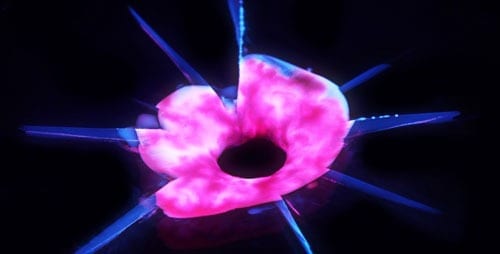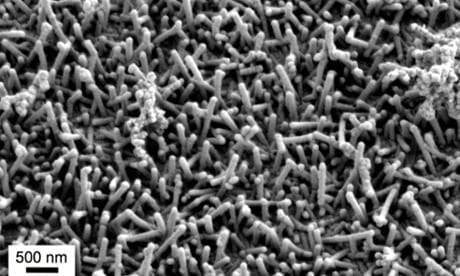
SLIPS: Slippery Liquid-Infused Porous Surfaces
An Unmet Need
A simple, inexpensive, and robust material that repels a variety of liquids and solids has immediate relevance to applications ranging from biomedical devices to architecture and fuel transport. Unwanted interactions between liquids and surfaces are currently a limiting factor nearly everywhere liquids are handled or encountered: they create drag in transport systems, trigger fouling in medical tubing, nucleate icing on power lines, promote growth of bacteria, and interfere with sensing devices. Most state-of-the-art liquid repellent surfaces are modeled after lotus leaves, which, due to their rough, waxy surface and contact angle characteristics, are known to exhibit superhydrophobicity and self-cleaning as water droplets remove contaminants from their surfaces when they roll-off. Despite over a decade of intense research, these surfaces are, however, still plagued with problems that restrict their practical applications: they show limited repellency to oils; they fail under pressure and upon any physical stress; they cannot self-heal; and they are expensive to produce.
Wyss Institute SLIPS Technology
Our SLIPS technology, inspired by the Nepenthes pitcher plant, provides unique capabilities that are unmatched by any other liquid-repellent surface technologies. SLIPS surfaces function under extreme high pressure conditions, instantly self-heal imperfections, provide optical transparency, and are ultra-repellent to pure and complex fluids such as blood, crude oil, and brine. They also repel solids such as ice and wax. These properties allow the slippery surfaces to be used in a wide variety of applications and environments. In addition, the slippery surfaces can be constructed from a broad range of simple, inexpensive materials without the need for specialized fabrication facilities. This makes them practical for use on a large scale, such as anti-grafitti walls, at a reasonable cost.
SLIPS as repellent coatings
SLIPS can be optimized for extreme temperature and pressure conditions, rapid self-healing, biocompatibility, optical transparency, and chemical inertness. These properties enable us to envision many potential applications that take advantage of one or a combination of these features and that are beyond the reach of current repellent technologies. For example, the temperature and pressure stabilities of SLIPS make it ideal for energy-efficient, high temperature transport of economically important fluids such as crude oil and biofuels, for economical heating/cooling systems, or as ice-resistant coatings for devices/instruments operating in refrigerated, or even in polar environments. In addition, the optical transparency (in the visible and near-IR range) and self-cleaning properties of SLIPS allow it to be used for stain-resistant coatings on optical surfaces, such as solar cells, lenses, sensors, and night-vision devices. The biocompatibility of SLIPS and its ability to repel biological fluids allow its application in anti-biofouling coatings for medical devices and instruments, and even for marine vessels, while its pressure resistance is well-suited for deep-sea exploration. In a separate area of potential utility, the omniphobic nature of SLIPS provides a unique insect-repellent capacity – directly analogous to the pitcher plant – which would be useful for pest barriers, on which ants and other insects would literally slip off of the thresholds and foundations of protected structures.
via Wyss Institute
The Latest on: Superhydrophobicity
[google_news title=”” keyword=”Superhydrophobicity” num_posts=”10″ blurb_length=”0″ show_thumb=”left”]
via Google News
The Latest on: Superhydrophobicity
- Superwettability: Controlling Surface Interactions at the Nanoscaleon March 20, 2024 at 3:15 am
Superwettable surfaces can exhibit either superhydrophobicity (extreme water repellency) or superhydrophilicity (extreme water attraction), depending on their chemical composition and physical ...
- Superhydrophobicity: Nature-Inspired Water Repellencyon March 20, 2024 at 3:15 am
Superhydrophobicity is a property of surfaces that exhibit extreme water repellency, characterized by water contact angles greater than 150°. In contrast to superhydrophilicity, where surfaces display ...
- Nilima Nanotechnologies Pvt ltdon October 3, 2017 at 4:11 am
This effect refers to the very high water repellency (superhydrophobicity) exhibited by the leaves of the lotus flower. Dirt particles are picked up by water droplets due to a complex micro- and ...
- Natural waterproofingon April 1, 2009 at 5:00 am
These properties seem to stem primarily from the micro- and nanostructured nature of the surfaces. Lotus leaves are covered with bumps called papillae, which are themselves coated with randomly ...
via Bing News










